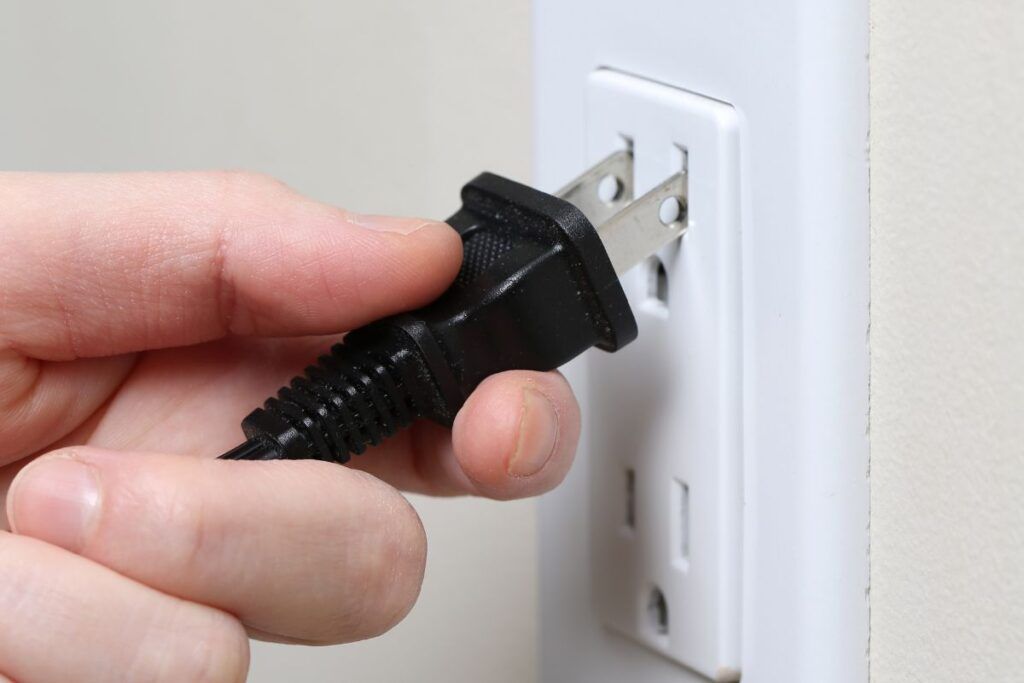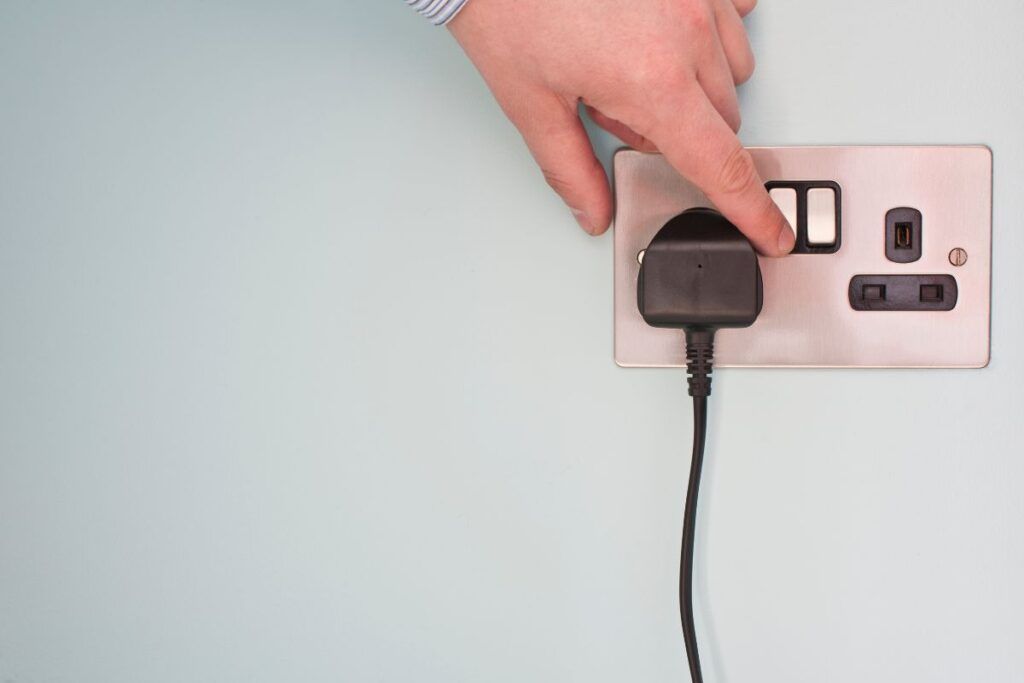If you use a 3-prong or a 4-prong plug, one prong will be for the grounding. It makes an alternative path for the current to flow during a ground fault or a short circuit. So, what happens if this prong is broken?
The grounding prong protects against sparks and surges. If broken, you become extremely vulnerable during short circuits and sudden surges. Replace the prong with a new plug or repair it with a soldering iron. The device may function without it, but the likelihood of getting shocked is very high.
If you are a beginner, you might panic when you see a broken prong. This article covers everything related to a broken ground prong in this article and the necessary steps to take.

Check out our list of top-handpicked products for all your electrical, appliance, and HVAC system needs to keep your home running smoothly.
This post includes some affiliate links.Understanding the importance of grounding prongs in electrical devices
In older times, most people used to have a 2-prong plug where you have only the live and neutral connection.
But nowadays, people use 3-prong and 4-prong plugs.
In a 3-prong plug, there wasn’t a dedicated ground wire.
There were two hot and one neutral wire, and the neutral acted as the grounding.
In a 4-prong plug, you have a dedicated grounding prong.
The grounding prong gives the electricity an extra path during a short circuit or ground fault.
As a result, the current flows through the grounding instead of your body and saves you from getting killed.
When you plug in the appliance, the current will flow from the hot wire through the appliance and return to the neutral wire.
When there is an interruption in this complete circuit, for example, a loose connection or damaged wires, the electricity will need a route with the least resistance and flow through the grounding.
Traveling through the ground prevents the current from flowing through your body.
Without the ground prong, you are vulnerable.
It should be connected to a metal grounding rod underground for proper grounding.
The rod gives a low-resistance path to the ground and helps dissipate the excess current during a fault or short circuit.
So, the third prong of the plug is very important in terms of safety.
Hazards of operating the electrical devices with a broken grounding prong

The grounding prong is supposed to provide safety from ground fault or electrocution.
It prevents spikes, short circuits, and surges from creating electrical accidents and fire hazards.
Without the ground prong, you become vulnerable.
So, operating an electrical device with a broken ground prong is dangerous.
The plug will work if it still contains the live and neutral prongs.
But the broken ground plug becomes dangerous once broken, increasing the risk of surges and sparks.
The broken prong can no longer protect you from fire or electrical accidents during such conditions.
You can keep the ground prong if there are no surges or sparks.
But you won’t have peace of mind using a broken grounding prong.
You will always be under constant stress about the prong.
In such a condition, you can use a 3-prong adapter.
Connect the plug with the broken ground prong to the adapter and then plug in the adapter to the outlet.
If you connect the adapter’s metal tab, it can give the grounding your plug needs.
However, such a setting will not work for devices with metal housing or plastic outlet boxes.
Additionally, the adapter cannot give you the desired ground connection if the outlet is not grounded.
The adapter’s tab will connect to the outlet’s ground connection; without that, the tab will be useless.
Except for these exceptions, the 3-prong adapters are useful to solve a problem like a broken grounding prong.
Without the adapter, you must replace the plug with a new one.
How to identify a broken grounding prong on the electrical device?
When you have a broken ground prong, you need to identify it to fix it.
Without a proper ground connection, there is a risk of electrocution during a fault or short circuit.
But how will you identify a broken grounding prong? Here are some signs:
- You will sometimes feel a mild shock whenever you turn on the device and accidentally touch its metal surface. The grounding prong prevents this shock from happening.
- You will sometimes see sparks in the plug whenever you turn on the device. These sparks can cause a short circuit if the grounding is broken.
- If the prong is broken, your device will not function properly or suddenly stop functioning.
For confirmation, try the following things:
- Unplug the device and check the prong closely.
- Once you have noticed the broken prong, test the device with a non-contact voltage tester to confirm the problem.
- The prong is broken if the tester does not give a proper grounding connection.
- Check the cord, and look for signs like fraying, cuts, or wire exposure from the insulation.
Common materials and tools required for repairing the broken prong
You will need the right materials for easy installation to replace the prong.
Here are some tools:
- Wire strippers or cutters will help to cut the cord close to the prong and expose the wire inside the insulation to connect them to the prong screws.
- Needle-nose pliers will allow you to take the broken prong out of the plug safely.
- A replacement prong will be needed to replace the broken prong. I have bought the Leviton 515PV 15 Amp, 125 Volt, Grounding Plug, and Yellow prong for my garage fan.
- The electrical tape helps cover any exposed wires after all the connections are made to avoid electrocution from touching.
- A voltage tester or multimeter will tell you that power is running in the prong and working well. I have used Klein Tools 69149 P Electrical Test Kit with Digital Multimeter, Non-contact Voltage Tester and Electrical Outlet Tester, Leads, and Batteries.
Steps to fix a broken grounding prong on electrical devices

To fix a broken grounding prong, you need to replace the prong or repair it.
Repairing a broken prong can be risky because it is not guaranteed to work, or using it can be safe.
Once the grounding prong breaks, the ground safety does not remain as effective as before.
But you can still try it. Below are the steps to both repair and replacement.
Replacing the prong
If you want to replace only the broken prong without changing the whole cord, here are some steps:
- First, turn off the power at the breaker and the outlet and unplug the appliance.
- Using a plier or wire stripper, remove the prong from the plug. Cut out the wire close to the prong.
- Strip off the cord and expose the three wires insulated with green, black/red, and white rubber.
- Strip off ½ inch of the insulation to expose the metal wire part of the three wires.
- Buy a new replacement prong to fix the old one. Get one from any hardware store. The prong will have a screw at its back to connect to the wire.
- Open up the replacement prong and insert the wires into their respective screws.
- Connect the black/red wire to the brass screw, the white wire to the silver screw, and the green wire to the green screw.
- Tighten and secure the connections and screws.
- Once you have replaced the prong, connect the plug to the outlet and check the appliance.
- Use a multimeter or a voltage tester to ensure the cord is properly grounded.
- If everything is fine, you can continue using it. Otherwise, you must replace the cord or call an electrician.
Repairing the broken prong
Though replacing the prong is preferred over repairing the broken one, you can still do it if it is only slightly broken.
Below are the steps:
- Turn off the breaker and unplug the appliance to examine the prong closely.
- If the prong is badly broken, you have to replace it. But if there is a slight or partial breakage, you can repair it.
- Use pliers to straighten the prong as much as possible.
- Reattach the broken prong with the soldering iron if the breakage is more. Heat the tip and apply it to the broken prong and the metal of the cord. Use a small amount of solder to reattach the prong.
- Make sure not to apply too much heat. Otherwise, the wire insulation will be damaged.
- After reattaching, straighten the prong slightly with pliers and plug it into the outlet. Check if it is working.
You can try this, but still, replacement is a better option than repair.
What happens if the broken ground prong is stuck in the outlet?
If your plug’s grounding prong has broken and got stuck inside the outlet, you have two options:
Removing the stuck prong
If the prong is not stuck too deep inside the outlet, you can remove it and bring it out.
Turn off the breaker and use needle-nose pliers to grab the prong. Use serrated jaw pliers.
Pull the prong out slowly and gently.
Some people end up breaking the slot while trying to remove the prong. So, be patient and gentle.
Remove the outlet
If the broken prong is not coming out of the outlet, you have to remove the outlet.
Once you get hold of the outlet, you can easily take out the broken prong.
Push the prong out from the back of the outlet.
Call an electrician or buy a new outlet if your prong still doesn’t come out.
Safety precautions to take when repairing a broken grounding prong
It is always best to leave electrical work in the hands of professionals.
They will follow the right codes and rules, have the right tools, and do things faster.
But if you want to do it yourself, here are a few safety precautions that you must follow:
- Turn off the power at the appliance or device’s circuit to avoid electrocution.
- Unplug the cord from the outlet before working.
- While working with the grounding prong, use the right tools, like electrical tape, pliers, wire strippers, etc., to make the work easier and faster.
- If you need to climb higher, use a wooden ladder instead of a metal.
- Wear protective gear like goggles and insulated gloves while working.
- Always use a voltage tester or a multimeter to confirm no power is running before you start working.
- Use a replacement prong that suits the appliance. Otherwise, it won’t run.
- Test the device after you have replaced it to ensure that your wired prong is working correctly.
Replacing vs. repairing a broken grounding prong: Pros and cons

When a grounding prong breaks, you can replace or repair it. Replacement is by far the best solution.
A broken grounding prong means you no longer receive the safety of the ground connection.
During sparks or short circuits, the chances of electrical accidents increase.
In the case of repair, you might have to involve soldering the iron.
Soldering can be dangerous if you haven’t done it before.
Let’s share the pros and cons of both.
Replacement: Pros
- Replacement is the safest option as you can get back the grounding of the appliance and use it further.
- Replacing the prong is affordable.
- Replacement is a long-term solution. A new prong will last longer than a repaired prong.
Replacement: Cons
- There are no cons to replacing the prong except that you need money and must wait to buy and replace it.
- In contrast, a repair can be done without waiting if you know the right process.
Repair: Pros
- Repair is quick, and you don’t have to buy any new prong to fix the broken prong.
- You can quickly repair and fix the prong if you need the appliance immediately.
Repair: Cons
- Repair is a temporary fix. Your grounding prong may break again after using it for some time.
- It may not give you proper safety like a new prong can provide. It depends on how well you have repaired it.
There is no safety or surety in repair, but it is fine for short-term and immediate results. For a long-term and safe solution, I always prefer replacement over repair.
Testing electrical devices for proper grounding after repairing a broken prong
Replacement is always the best option.
But if you have repaired your broken prong, testing the device and noticing its behavior is very important.
To test your electrical device after repairing the prong:
- Check that you have repaired the prong very well.
- Plug the prong into the outlet and test the appliance.
- Observe for sparks in the outlet.
- Use a multimeter or voltage tester to check the continuity of the prong and the ground pin of the outlet.
- Check the voltage of all the prongs in the cord.
- See if the appliance is running properly and examine for overheating.
- If you doubt it, turn off the device and call an electrician for a checkup.
Additional tips for maintaining the electrical devices and preventing grounding prong damage
Even though you can repair or replace a damaged prong, you must take care of the electrical devices and prevent such damage.
Here are some tips for caring for the devices and preventing prong damage:
- Always unplug the cord safely. Grip the plug and not the cord.
- When running the electrical devices, check for loose connections beforehand to avoid future damage.
- While plugging the device, insert the plug firmly and patiently without applying any force.
- Use the right outlet that suits your device plug.
- Keep your cord untangled to avoid unnecessary stress to them.
- Replace damaged plugs as soon as possible.
- Avoid keeping wet materials near the devices and wires.
- You can use surge protectors for bigger appliances to protect them from sudden power surges.
- Refrain from overloading your circuit with too many appliances.
- Avoid rough handling of electrical devices.
- Regularly clean and maintain your devices to increase their lifespan.
- Store your devices properly, especially when you are not using them. Please keep them in a dry place and avoid damp places.
Final thoughts
The grounding prong gives the current an alternate path to flow during a short circuit. As a result, you get saved from short circuits and fire hazards. A broken or missing ground prong means the plug is no longer grounded. So, the risk of electric shocks and sparks increases.
That is why it is better to replace or repair the prong quickly. Replacement is the best option because it is safe and a long-term solution. But if you want an immediate fix, the repair is fine.
After you have fixed the problem, test your device to see if it behaves normally like before. If not, hire a professional for a checkup. Follow the safety precautions and additional tips to remain safe and prevent prong damage.
Can I remove the broken ground prong?
Just because some plugs have two prongs doesn’t mean you can remove the broken grounding prong from your 3 or 4-prong plug. Removing makes you vulnerable and increases the chances of electric shocks and fire hazards. So, replace the plug.
Are adapters safe?
Though you can use adapters, they are seldom safe, especially for devices with metal housing, plastic wall box outlets, and ungrounded outlets.
Reference: Power cords Wikipedia

